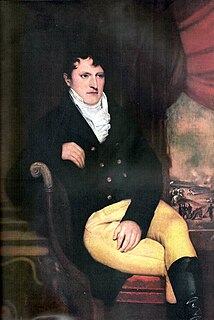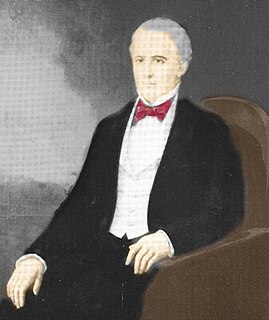
Manuel José Joaquín del Corazón de Jesús Belgrano y González, usually referred to as Manuel Belgrano, was an Argentine economist, lawyer, politician, and military leader. He took part in the Argentine Wars of Independence and created the Flag of Argentina. He is regarded as one of the main Libertadores of the country.

The May Revolution was a week-long series of events that took place from May 18 to 25, 1810, in Buenos Aires, capital of the Viceroyalty of the Río de la Plata. This Spanish colony included roughly the territories of present-day Argentina, Bolivia, Paraguay, Uruguay, and parts of Brazil. The result was the removal of Viceroy Baltasar Hidalgo de Cisneros and the establishment of a local government, the Primera Junta, on May 25. It was the first successful revolution in the South American Independence process.

Cornelio Judas Tadeo de Saavedra y Rodríguez was a military officer and statesman from the Viceroyalty of the Río de la Plata. He was instrumental in the May Revolution, the first step of Argentina's independence from Spain, and was appointed president of the Primera Junta.

Baltasar Hidalgo de Cisneros y de la Torre (1756–1829) was a Spanish naval officer born in Cartagena. He took part in the Battle of Cape St Vincent and the Battle of Trafalgar, and in the Spanish resistance against Napoleon's invasion in 1808. He was later appointed Viceroy of the Viceroyalty of the Río de la Plata, replacing Santiago de Liniers. He disestablished the government Junta of Javier de Elío and quelled the Chuquisaca Revolution and the La Paz revolution. An open cabildo deposed him as viceroy during the May Revolution, but he attempted to be the president of the new government junta, thus retaining power. The popular unrest in Buenos Aires did not allow that, so he resigned. He was banished back to Spain shortly after that, and died in 1829.

The United Provinces of the Río de la Plata, earlier known as the United Provinces of South America, a union of provinces in the Río de la Plata region of South America, emerged from the May Revolution in 1810 and the Argentine War of Independence of 1810–1818. It comprised most of the former Viceroyalty of the Río de la Plata dependencies and had Buenos Aires as its capital.

Juan José Castelli was an Argentine lawyer. He was one of the leaders of the May Revolution, which started the Argentine War of Independence. He led an ill-fated military campaign in Upper Peru.

Miguel de Azcuénaga was an Argentine brigadier. Educated in Spain, at the University of Seville, Azcuénaga began his military career in the Viceroyalty of the Río de la Plata and became a member of the Primera Junta, the first autonomous government of modern Argentina. He was shortly exiled because of his support to the minister Mariano Moreno, and returned to Buenos Aires when the First Triumvirate replaced the Junta. He held several offices since then, most notably being the first Governor intendant of Buenos Aires after the May Revolution. He died at his country house in 1833.

The Paraguay campaign (1810–11) was the attempt by a Buenos Aires-sponsored militia, commanded by Manuel Belgrano, to win the royalist Intendency of Paraguay for the cause of May Revolution. In Paraguay it is considered as their War of Independence. The first battles fought were the Battle of Campichuelo and Battle of Campo Maracana, in which Argentinians claimed victory. However, they were completely vanquished in the subsequent Battle of Paraguarí and Battle of Tacuarí. The campaign ended in a military failure and Paraguay broke its links with the Spanish crown just two months after Belgrano's withdrawal, starting its course towards full independence.

Juan Larrea was a Spanish businessman and politician in Buenos Aires during the early nineteenth century. He headed a military unit during the second British invasion of the Río de la Plata, and worked at the Buenos Aires Cabildo. He took part in the ill-fated Mutiny of Álzaga. Larrea and Domingo Matheu were the only two Spanish-born members of the Primera Junta, the first national government of Argentina.
Pascual Ruiz Huidobro, was a Spanish soldier in the Viceroyalty of the Río de la Plata, who fought against the British invasions of the Río de la Plata as Governor of Montevideo.

Domingo Bartolomé Francisco Matheu was a Spanish-born Argentine businessman and politician. He was a member of the Primera Junta, the first national government of modern Argentina, and the second president in the end of the Junta Grande from August to September 1811.

Gregorio Funes, also known as Deán Funes, was an Argentine clergyman, educator, historian, journalist and lawmaker who played a significant role in his nation's early, post-independence history.

Colonial Argentina is designated as the period of the History of Argentina when it was an overseas colony of the Spanish Empire. It begins in the precolumbian age of the indigenous peoples of Argentina, with the arrival of the first Spanish conqueror.

The Argentine War of Independence was fought from 1810 to 1818 by Argentine patriotic forces under Manuel Belgrano, Juan José Castelli and José de San Martín against royalist forces loyal to the Spanish crown. On July 9, 1816, an assembly met in San Miguel de Tucumán, declared full independence with provisions for a national constitution.

The dissolution of the Viceroyalty of the Río de la Plata was the independence and breaking up of the Spanish colony in South America. Most of the viceroyalty is now part of Argentina, and other regions belong to Bolivia, Brazil, Paraguay and Uruguay.






















